Business Environment of TESCO: Types, Functions, and Analysis
VerifiedAdded on 2020/06/04
|13
|5379
|275
Report
AI Summary
This report offers a comprehensive analysis of TESCO's business environment, encompassing various organizational types such as private, public, and voluntary sectors, and their respective purposes and legal structures. It explores the size and scope of different organizations, with a specific focus on TESCO, Nestle, and Oxfam. The report then delves into the interconnectedness of organizational functions, including human resources, finance, sales and marketing, research and development, and production and operations, with TESCO's overall objectives and structure. Furthermore, it examines the positive and negative impacts of the macro environment on TESCO, along with an internal and external analysis of the company. The analysis includes how strengths and weaknesses are related to external macro factors, providing a holistic view of TESCO's operational dynamics within its business environment.
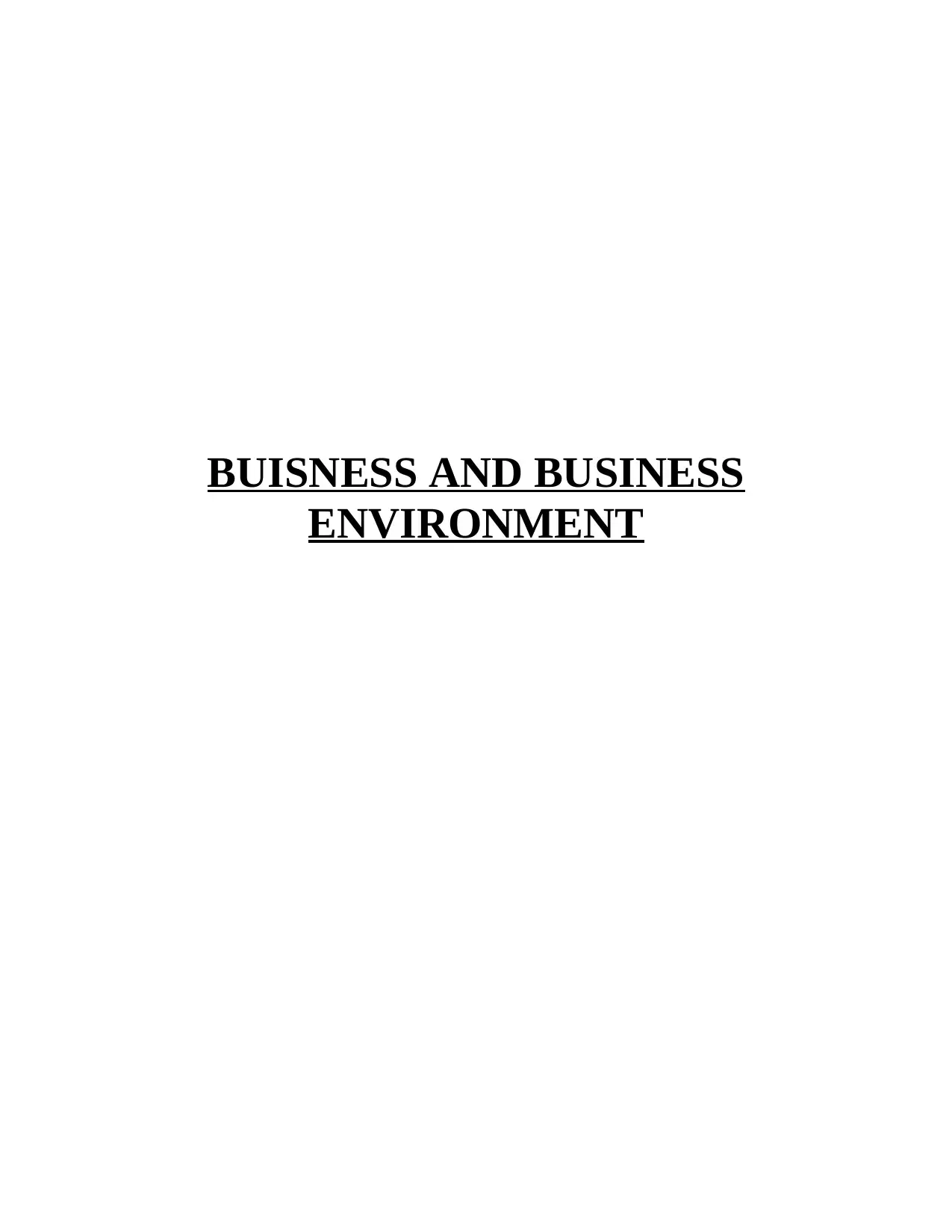
BUISNESS AND BUSINESS
ENVIRONMENT
ENVIRONMENT
Paraphrase This Document
Need a fresh take? Get an instant paraphrase of this document with our AI Paraphraser
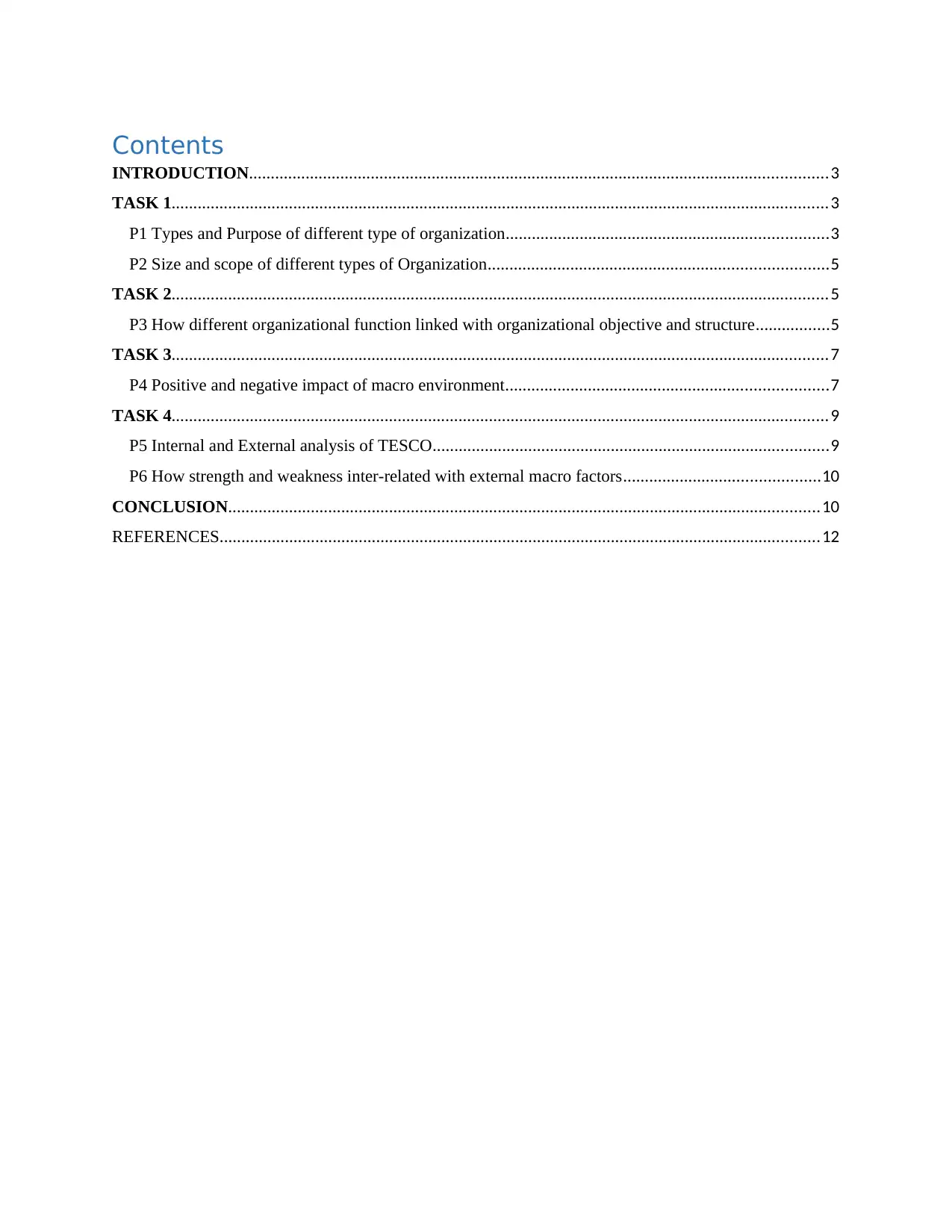
Contents
INTRODUCTION.....................................................................................................................................3
TASK 1.......................................................................................................................................................3
P1 Types and Purpose of different type of organization..........................................................................3
P2 Size and scope of different types of Organization..............................................................................5
TASK 2.......................................................................................................................................................5
P3 How different organizational function linked with organizational objective and structure.................5
TASK 3.......................................................................................................................................................7
P4 Positive and negative impact of macro environment..........................................................................7
TASK 4.......................................................................................................................................................9
P5 Internal and External analysis of TESCO...........................................................................................9
P6 How strength and weakness inter-related with external macro factors.............................................10
CONCLUSION........................................................................................................................................10
REFERENCES..........................................................................................................................................12
INTRODUCTION.....................................................................................................................................3
TASK 1.......................................................................................................................................................3
P1 Types and Purpose of different type of organization..........................................................................3
P2 Size and scope of different types of Organization..............................................................................5
TASK 2.......................................................................................................................................................5
P3 How different organizational function linked with organizational objective and structure.................5
TASK 3.......................................................................................................................................................7
P4 Positive and negative impact of macro environment..........................................................................7
TASK 4.......................................................................................................................................................9
P5 Internal and External analysis of TESCO...........................................................................................9
P6 How strength and weakness inter-related with external macro factors.............................................10
CONCLUSION........................................................................................................................................10
REFERENCES..........................................................................................................................................12
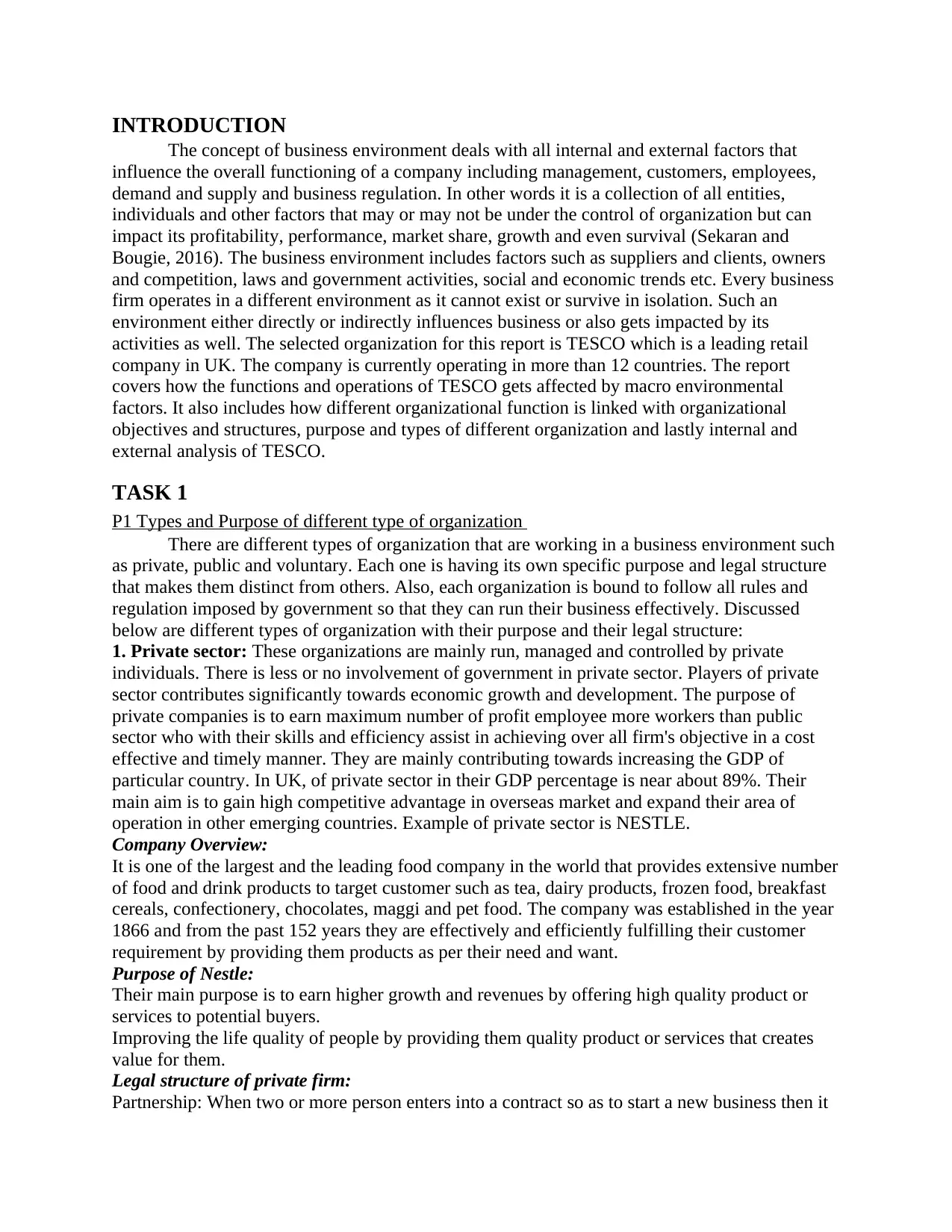
INTRODUCTION
The concept of business environment deals with all internal and external factors that
influence the overall functioning of a company including management, customers, employees,
demand and supply and business regulation. In other words it is a collection of all entities,
individuals and other factors that may or may not be under the control of organization but can
impact its profitability, performance, market share, growth and even survival (Sekaran and
Bougie, 2016). The business environment includes factors such as suppliers and clients, owners
and competition, laws and government activities, social and economic trends etc. Every business
firm operates in a different environment as it cannot exist or survive in isolation. Such an
environment either directly or indirectly influences business or also gets impacted by its
activities as well. The selected organization for this report is TESCO which is a leading retail
company in UK. The company is currently operating in more than 12 countries. The report
covers how the functions and operations of TESCO gets affected by macro environmental
factors. It also includes how different organizational function is linked with organizational
objectives and structures, purpose and types of different organization and lastly internal and
external analysis of TESCO.
TASK 1
P1 Types and Purpose of different type of organization
There are different types of organization that are working in a business environment such
as private, public and voluntary. Each one is having its own specific purpose and legal structure
that makes them distinct from others. Also, each organization is bound to follow all rules and
regulation imposed by government so that they can run their business effectively. Discussed
below are different types of organization with their purpose and their legal structure:
1. Private sector: These organizations are mainly run, managed and controlled by private
individuals. There is less or no involvement of government in private sector. Players of private
sector contributes significantly towards economic growth and development. The purpose of
private companies is to earn maximum number of profit employee more workers than public
sector who with their skills and efficiency assist in achieving over all firm's objective in a cost
effective and timely manner. They are mainly contributing towards increasing the GDP of
particular country. In UK, of private sector in their GDP percentage is near about 89%. Their
main aim is to gain high competitive advantage in overseas market and expand their area of
operation in other emerging countries. Example of private sector is NESTLE.
Company Overview:
It is one of the largest and the leading food company in the world that provides extensive number
of food and drink products to target customer such as tea, dairy products, frozen food, breakfast
cereals, confectionery, chocolates, maggi and pet food. The company was established in the year
1866 and from the past 152 years they are effectively and efficiently fulfilling their customer
requirement by providing them products as per their need and want.
Purpose of Nestle:
Their main purpose is to earn higher growth and revenues by offering high quality product or
services to potential buyers.
Improving the life quality of people by providing them quality product or services that creates
value for them.
Legal structure of private firm:
Partnership: When two or more person enters into a contract so as to start a new business then it
The concept of business environment deals with all internal and external factors that
influence the overall functioning of a company including management, customers, employees,
demand and supply and business regulation. In other words it is a collection of all entities,
individuals and other factors that may or may not be under the control of organization but can
impact its profitability, performance, market share, growth and even survival (Sekaran and
Bougie, 2016). The business environment includes factors such as suppliers and clients, owners
and competition, laws and government activities, social and economic trends etc. Every business
firm operates in a different environment as it cannot exist or survive in isolation. Such an
environment either directly or indirectly influences business or also gets impacted by its
activities as well. The selected organization for this report is TESCO which is a leading retail
company in UK. The company is currently operating in more than 12 countries. The report
covers how the functions and operations of TESCO gets affected by macro environmental
factors. It also includes how different organizational function is linked with organizational
objectives and structures, purpose and types of different organization and lastly internal and
external analysis of TESCO.
TASK 1
P1 Types and Purpose of different type of organization
There are different types of organization that are working in a business environment such
as private, public and voluntary. Each one is having its own specific purpose and legal structure
that makes them distinct from others. Also, each organization is bound to follow all rules and
regulation imposed by government so that they can run their business effectively. Discussed
below are different types of organization with their purpose and their legal structure:
1. Private sector: These organizations are mainly run, managed and controlled by private
individuals. There is less or no involvement of government in private sector. Players of private
sector contributes significantly towards economic growth and development. The purpose of
private companies is to earn maximum number of profit employee more workers than public
sector who with their skills and efficiency assist in achieving over all firm's objective in a cost
effective and timely manner. They are mainly contributing towards increasing the GDP of
particular country. In UK, of private sector in their GDP percentage is near about 89%. Their
main aim is to gain high competitive advantage in overseas market and expand their area of
operation in other emerging countries. Example of private sector is NESTLE.
Company Overview:
It is one of the largest and the leading food company in the world that provides extensive number
of food and drink products to target customer such as tea, dairy products, frozen food, breakfast
cereals, confectionery, chocolates, maggi and pet food. The company was established in the year
1866 and from the past 152 years they are effectively and efficiently fulfilling their customer
requirement by providing them products as per their need and want.
Purpose of Nestle:
Their main purpose is to earn higher growth and revenues by offering high quality product or
services to potential buyers.
Improving the life quality of people by providing them quality product or services that creates
value for them.
Legal structure of private firm:
Partnership: When two or more person enters into a contract so as to start a new business then it
⊘ This is a preview!⊘
Do you want full access?
Subscribe today to unlock all pages.

Trusted by 1+ million students worldwide
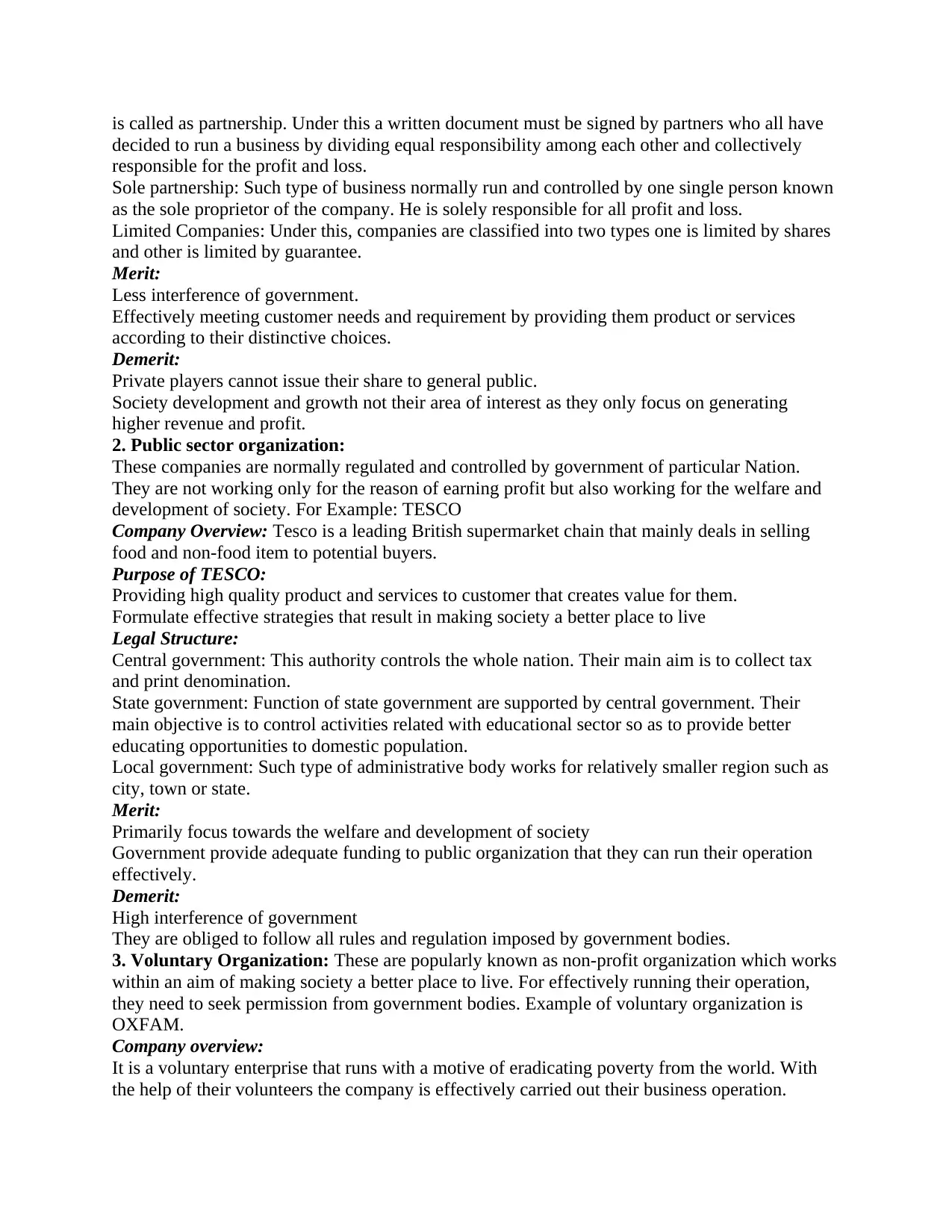
is called as partnership. Under this a written document must be signed by partners who all have
decided to run a business by dividing equal responsibility among each other and collectively
responsible for the profit and loss.
Sole partnership: Such type of business normally run and controlled by one single person known
as the sole proprietor of the company. He is solely responsible for all profit and loss.
Limited Companies: Under this, companies are classified into two types one is limited by shares
and other is limited by guarantee.
Merit:
Less interference of government.
Effectively meeting customer needs and requirement by providing them product or services
according to their distinctive choices.
Demerit:
Private players cannot issue their share to general public.
Society development and growth not their area of interest as they only focus on generating
higher revenue and profit.
2. Public sector organization:
These companies are normally regulated and controlled by government of particular Nation.
They are not working only for the reason of earning profit but also working for the welfare and
development of society. For Example: TESCO
Company Overview: Tesco is a leading British supermarket chain that mainly deals in selling
food and non-food item to potential buyers.
Purpose of TESCO:
Providing high quality product and services to customer that creates value for them.
Formulate effective strategies that result in making society a better place to live
Legal Structure:
Central government: This authority controls the whole nation. Their main aim is to collect tax
and print denomination.
State government: Function of state government are supported by central government. Their
main objective is to control activities related with educational sector so as to provide better
educating opportunities to domestic population.
Local government: Such type of administrative body works for relatively smaller region such as
city, town or state.
Merit:
Primarily focus towards the welfare and development of society
Government provide adequate funding to public organization that they can run their operation
effectively.
Demerit:
High interference of government
They are obliged to follow all rules and regulation imposed by government bodies.
3. Voluntary Organization: These are popularly known as non-profit organization which works
within an aim of making society a better place to live. For effectively running their operation,
they need to seek permission from government bodies. Example of voluntary organization is
OXFAM.
Company overview:
It is a voluntary enterprise that runs with a motive of eradicating poverty from the world. With
the help of their volunteers the company is effectively carried out their business operation.
decided to run a business by dividing equal responsibility among each other and collectively
responsible for the profit and loss.
Sole partnership: Such type of business normally run and controlled by one single person known
as the sole proprietor of the company. He is solely responsible for all profit and loss.
Limited Companies: Under this, companies are classified into two types one is limited by shares
and other is limited by guarantee.
Merit:
Less interference of government.
Effectively meeting customer needs and requirement by providing them product or services
according to their distinctive choices.
Demerit:
Private players cannot issue their share to general public.
Society development and growth not their area of interest as they only focus on generating
higher revenue and profit.
2. Public sector organization:
These companies are normally regulated and controlled by government of particular Nation.
They are not working only for the reason of earning profit but also working for the welfare and
development of society. For Example: TESCO
Company Overview: Tesco is a leading British supermarket chain that mainly deals in selling
food and non-food item to potential buyers.
Purpose of TESCO:
Providing high quality product and services to customer that creates value for them.
Formulate effective strategies that result in making society a better place to live
Legal Structure:
Central government: This authority controls the whole nation. Their main aim is to collect tax
and print denomination.
State government: Function of state government are supported by central government. Their
main objective is to control activities related with educational sector so as to provide better
educating opportunities to domestic population.
Local government: Such type of administrative body works for relatively smaller region such as
city, town or state.
Merit:
Primarily focus towards the welfare and development of society
Government provide adequate funding to public organization that they can run their operation
effectively.
Demerit:
High interference of government
They are obliged to follow all rules and regulation imposed by government bodies.
3. Voluntary Organization: These are popularly known as non-profit organization which works
within an aim of making society a better place to live. For effectively running their operation,
they need to seek permission from government bodies. Example of voluntary organization is
OXFAM.
Company overview:
It is a voluntary enterprise that runs with a motive of eradicating poverty from the world. With
the help of their volunteers the company is effectively carried out their business operation.
Paraphrase This Document
Need a fresh take? Get an instant paraphrase of this document with our AI Paraphraser
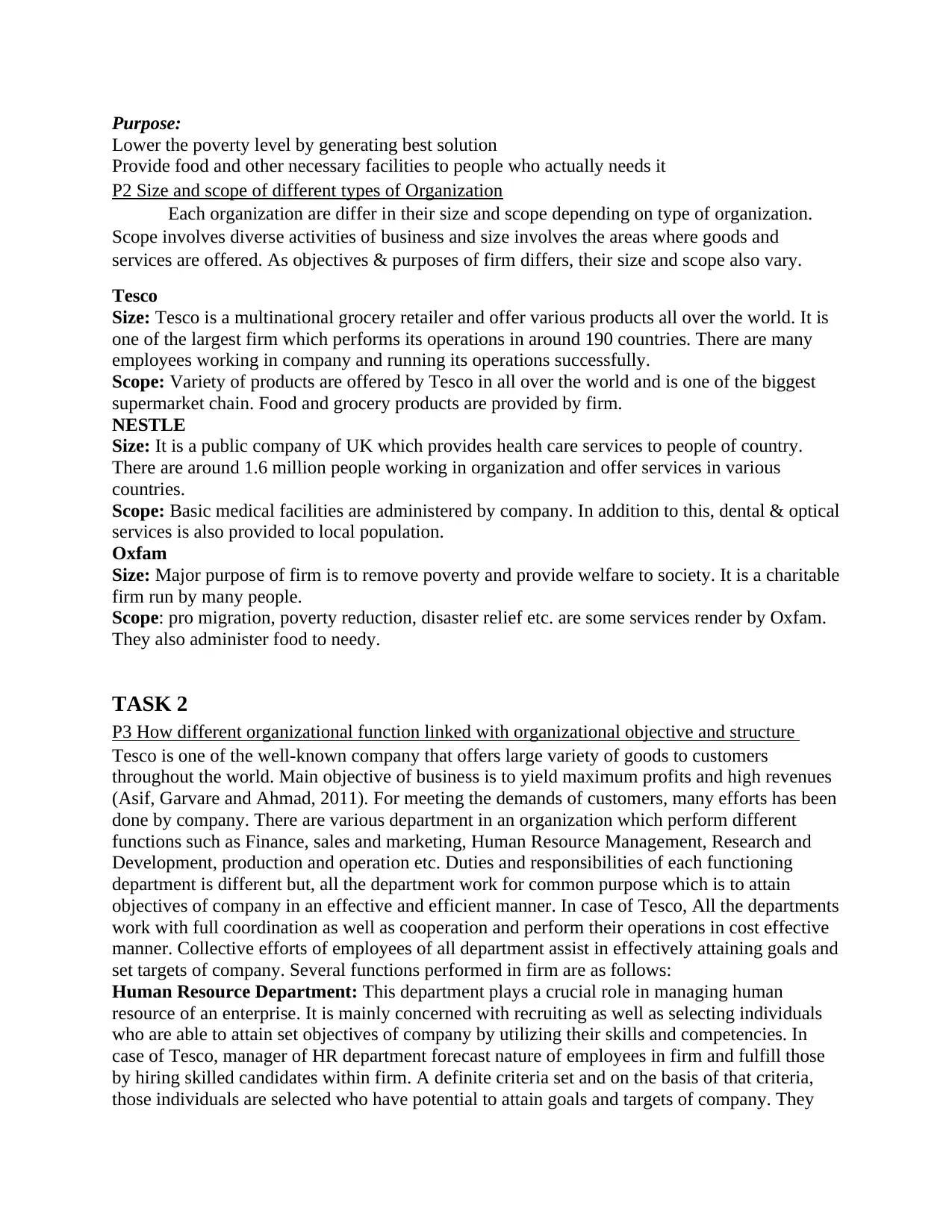
Purpose:
Lower the poverty level by generating best solution
Provide food and other necessary facilities to people who actually needs it
P2 Size and scope of different types of Organization
Each organization are differ in their size and scope depending on type of organization.
Scope involves diverse activities of business and size involves the areas where goods and
services are offered. As objectives & purposes of firm differs, their size and scope also vary.
Tesco
Size: Tesco is a multinational grocery retailer and offer various products all over the world. It is
one of the largest firm which performs its operations in around 190 countries. There are many
employees working in company and running its operations successfully.
Scope: Variety of products are offered by Tesco in all over the world and is one of the biggest
supermarket chain. Food and grocery products are provided by firm.
NESTLE
Size: It is a public company of UK which provides health care services to people of country.
There are around 1.6 million people working in organization and offer services in various
countries.
Scope: Basic medical facilities are administered by company. In addition to this, dental & optical
services is also provided to local population.
Oxfam
Size: Major purpose of firm is to remove poverty and provide welfare to society. It is a charitable
firm run by many people.
Scope: pro migration, poverty reduction, disaster relief etc. are some services render by Oxfam.
They also administer food to needy.
TASK 2
P3 How different organizational function linked with organizational objective and structure
Tesco is one of the well-known company that offers large variety of goods to customers
throughout the world. Main objective of business is to yield maximum profits and high revenues
(Asif, Garvare and Ahmad, 2011). For meeting the demands of customers, many efforts has been
done by company. There are various department in an organization which perform different
functions such as Finance, sales and marketing, Human Resource Management, Research and
Development, production and operation etc. Duties and responsibilities of each functioning
department is different but, all the department work for common purpose which is to attain
objectives of company in an effective and efficient manner. In case of Tesco, All the departments
work with full coordination as well as cooperation and perform their operations in cost effective
manner. Collective efforts of employees of all department assist in effectively attaining goals and
set targets of company. Several functions performed in firm are as follows:
Human Resource Department: This department plays a crucial role in managing human
resource of an enterprise. It is mainly concerned with recruiting as well as selecting individuals
who are able to attain set objectives of company by utilizing their skills and competencies. In
case of Tesco, manager of HR department forecast nature of employees in firm and fulfill those
by hiring skilled candidates within firm. A definite criteria set and on the basis of that criteria,
those individuals are selected who have potential to attain goals and targets of company. They
Lower the poverty level by generating best solution
Provide food and other necessary facilities to people who actually needs it
P2 Size and scope of different types of Organization
Each organization are differ in their size and scope depending on type of organization.
Scope involves diverse activities of business and size involves the areas where goods and
services are offered. As objectives & purposes of firm differs, their size and scope also vary.
Tesco
Size: Tesco is a multinational grocery retailer and offer various products all over the world. It is
one of the largest firm which performs its operations in around 190 countries. There are many
employees working in company and running its operations successfully.
Scope: Variety of products are offered by Tesco in all over the world and is one of the biggest
supermarket chain. Food and grocery products are provided by firm.
NESTLE
Size: It is a public company of UK which provides health care services to people of country.
There are around 1.6 million people working in organization and offer services in various
countries.
Scope: Basic medical facilities are administered by company. In addition to this, dental & optical
services is also provided to local population.
Oxfam
Size: Major purpose of firm is to remove poverty and provide welfare to society. It is a charitable
firm run by many people.
Scope: pro migration, poverty reduction, disaster relief etc. are some services render by Oxfam.
They also administer food to needy.
TASK 2
P3 How different organizational function linked with organizational objective and structure
Tesco is one of the well-known company that offers large variety of goods to customers
throughout the world. Main objective of business is to yield maximum profits and high revenues
(Asif, Garvare and Ahmad, 2011). For meeting the demands of customers, many efforts has been
done by company. There are various department in an organization which perform different
functions such as Finance, sales and marketing, Human Resource Management, Research and
Development, production and operation etc. Duties and responsibilities of each functioning
department is different but, all the department work for common purpose which is to attain
objectives of company in an effective and efficient manner. In case of Tesco, All the departments
work with full coordination as well as cooperation and perform their operations in cost effective
manner. Collective efforts of employees of all department assist in effectively attaining goals and
set targets of company. Several functions performed in firm are as follows:
Human Resource Department: This department plays a crucial role in managing human
resource of an enterprise. It is mainly concerned with recruiting as well as selecting individuals
who are able to attain set objectives of company by utilizing their skills and competencies. In
case of Tesco, manager of HR department forecast nature of employees in firm and fulfill those
by hiring skilled candidates within firm. A definite criteria set and on the basis of that criteria,
those individuals are selected who have potential to attain goals and targets of company. They
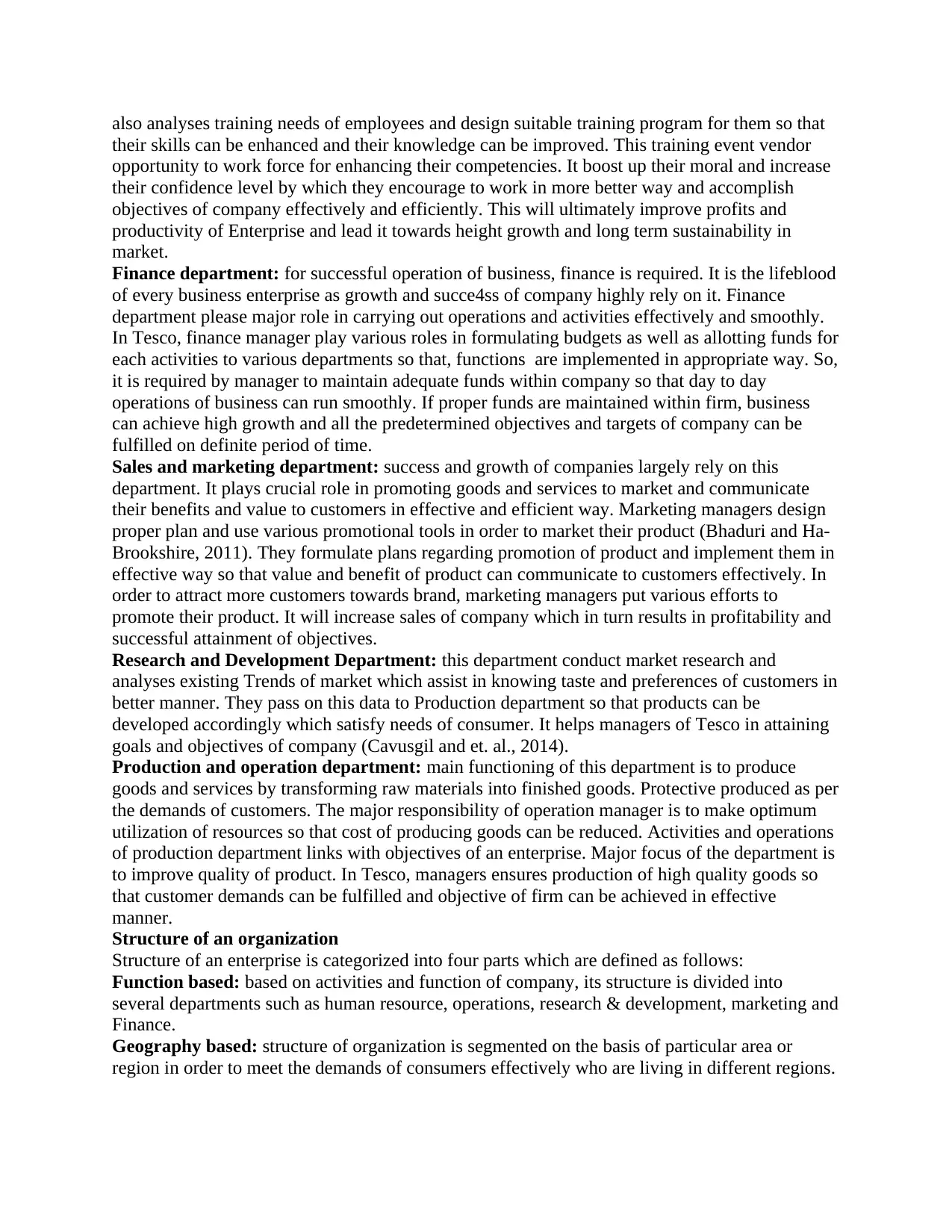
also analyses training needs of employees and design suitable training program for them so that
their skills can be enhanced and their knowledge can be improved. This training event vendor
opportunity to work force for enhancing their competencies. It boost up their moral and increase
their confidence level by which they encourage to work in more better way and accomplish
objectives of company effectively and efficiently. This will ultimately improve profits and
productivity of Enterprise and lead it towards height growth and long term sustainability in
market.
Finance department: for successful operation of business, finance is required. It is the lifeblood
of every business enterprise as growth and succe4ss of company highly rely on it. Finance
department please major role in carrying out operations and activities effectively and smoothly.
In Tesco, finance manager play various roles in formulating budgets as well as allotting funds for
each activities to various departments so that, functions are implemented in appropriate way. So,
it is required by manager to maintain adequate funds within company so that day to day
operations of business can run smoothly. If proper funds are maintained within firm, business
can achieve high growth and all the predetermined objectives and targets of company can be
fulfilled on definite period of time.
Sales and marketing department: success and growth of companies largely rely on this
department. It plays crucial role in promoting goods and services to market and communicate
their benefits and value to customers in effective and efficient way. Marketing managers design
proper plan and use various promotional tools in order to market their product (Bhaduri and Ha-
Brookshire, 2011). They formulate plans regarding promotion of product and implement them in
effective way so that value and benefit of product can communicate to customers effectively. In
order to attract more customers towards brand, marketing managers put various efforts to
promote their product. It will increase sales of company which in turn results in profitability and
successful attainment of objectives.
Research and Development Department: this department conduct market research and
analyses existing Trends of market which assist in knowing taste and preferences of customers in
better manner. They pass on this data to Production department so that products can be
developed accordingly which satisfy needs of consumer. It helps managers of Tesco in attaining
goals and objectives of company (Cavusgil and et. al., 2014).
Production and operation department: main functioning of this department is to produce
goods and services by transforming raw materials into finished goods. Protective produced as per
the demands of customers. The major responsibility of operation manager is to make optimum
utilization of resources so that cost of producing goods can be reduced. Activities and operations
of production department links with objectives of an enterprise. Major focus of the department is
to improve quality of product. In Tesco, managers ensures production of high quality goods so
that customer demands can be fulfilled and objective of firm can be achieved in effective
manner.
Structure of an organization
Structure of an enterprise is categorized into four parts which are defined as follows:
Function based: based on activities and function of company, its structure is divided into
several departments such as human resource, operations, research & development, marketing and
Finance.
Geography based: structure of organization is segmented on the basis of particular area or
region in order to meet the demands of consumers effectively who are living in different regions.
their skills can be enhanced and their knowledge can be improved. This training event vendor
opportunity to work force for enhancing their competencies. It boost up their moral and increase
their confidence level by which they encourage to work in more better way and accomplish
objectives of company effectively and efficiently. This will ultimately improve profits and
productivity of Enterprise and lead it towards height growth and long term sustainability in
market.
Finance department: for successful operation of business, finance is required. It is the lifeblood
of every business enterprise as growth and succe4ss of company highly rely on it. Finance
department please major role in carrying out operations and activities effectively and smoothly.
In Tesco, finance manager play various roles in formulating budgets as well as allotting funds for
each activities to various departments so that, functions are implemented in appropriate way. So,
it is required by manager to maintain adequate funds within company so that day to day
operations of business can run smoothly. If proper funds are maintained within firm, business
can achieve high growth and all the predetermined objectives and targets of company can be
fulfilled on definite period of time.
Sales and marketing department: success and growth of companies largely rely on this
department. It plays crucial role in promoting goods and services to market and communicate
their benefits and value to customers in effective and efficient way. Marketing managers design
proper plan and use various promotional tools in order to market their product (Bhaduri and Ha-
Brookshire, 2011). They formulate plans regarding promotion of product and implement them in
effective way so that value and benefit of product can communicate to customers effectively. In
order to attract more customers towards brand, marketing managers put various efforts to
promote their product. It will increase sales of company which in turn results in profitability and
successful attainment of objectives.
Research and Development Department: this department conduct market research and
analyses existing Trends of market which assist in knowing taste and preferences of customers in
better manner. They pass on this data to Production department so that products can be
developed accordingly which satisfy needs of consumer. It helps managers of Tesco in attaining
goals and objectives of company (Cavusgil and et. al., 2014).
Production and operation department: main functioning of this department is to produce
goods and services by transforming raw materials into finished goods. Protective produced as per
the demands of customers. The major responsibility of operation manager is to make optimum
utilization of resources so that cost of producing goods can be reduced. Activities and operations
of production department links with objectives of an enterprise. Major focus of the department is
to improve quality of product. In Tesco, managers ensures production of high quality goods so
that customer demands can be fulfilled and objective of firm can be achieved in effective
manner.
Structure of an organization
Structure of an enterprise is categorized into four parts which are defined as follows:
Function based: based on activities and function of company, its structure is divided into
several departments such as human resource, operations, research & development, marketing and
Finance.
Geography based: structure of organization is segmented on the basis of particular area or
region in order to meet the demands of consumers effectively who are living in different regions.
⊘ This is a preview!⊘
Do you want full access?
Subscribe today to unlock all pages.

Trusted by 1+ million students worldwide
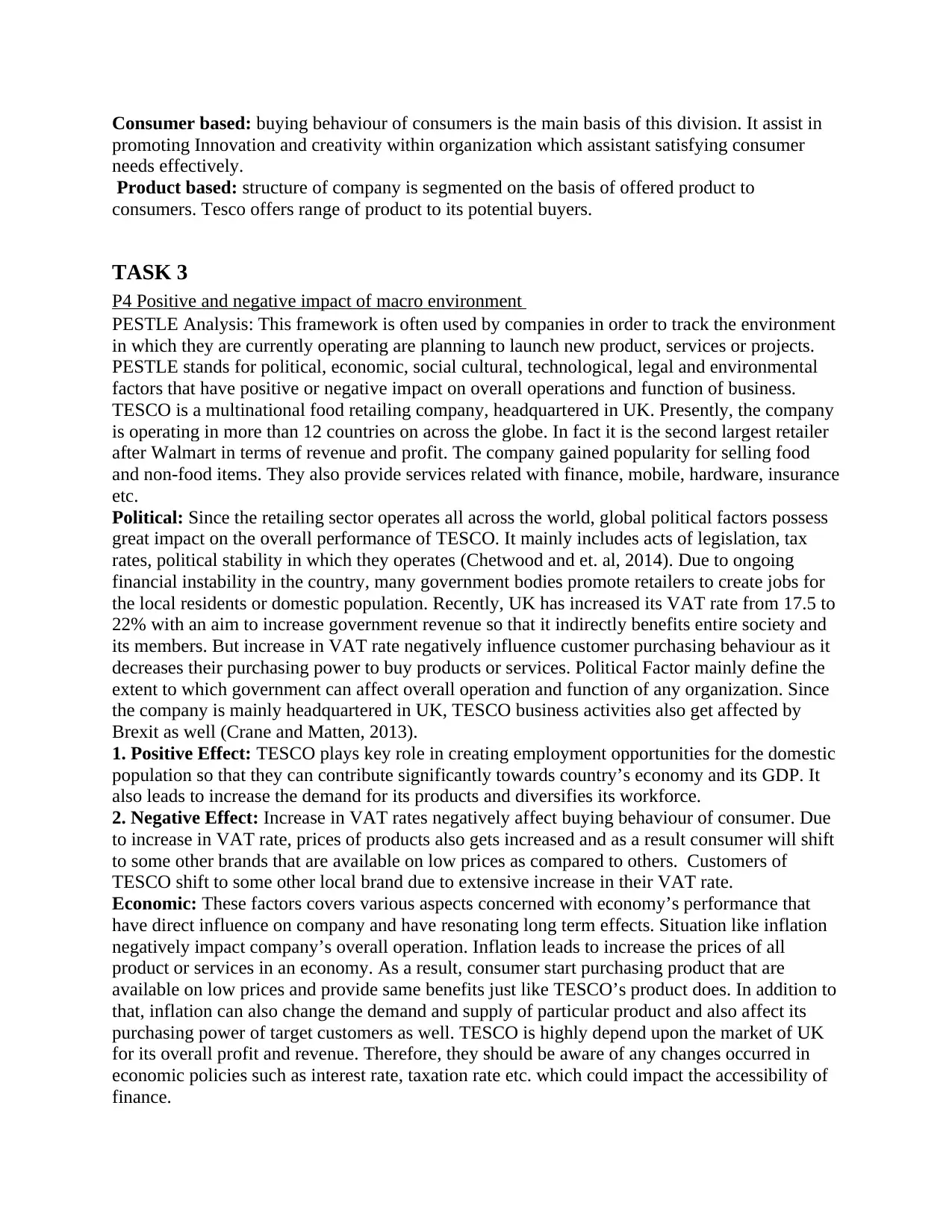
Consumer based: buying behaviour of consumers is the main basis of this division. It assist in
promoting Innovation and creativity within organization which assistant satisfying consumer
needs effectively.
Product based: structure of company is segmented on the basis of offered product to
consumers. Tesco offers range of product to its potential buyers.
TASK 3
P4 Positive and negative impact of macro environment
PESTLE Analysis: This framework is often used by companies in order to track the environment
in which they are currently operating are planning to launch new product, services or projects.
PESTLE stands for political, economic, social cultural, technological, legal and environmental
factors that have positive or negative impact on overall operations and function of business.
TESCO is a multinational food retailing company, headquartered in UK. Presently, the company
is operating in more than 12 countries on across the globe. In fact it is the second largest retailer
after Walmart in terms of revenue and profit. The company gained popularity for selling food
and non-food items. They also provide services related with finance, mobile, hardware, insurance
etc.
Political: Since the retailing sector operates all across the world, global political factors possess
great impact on the overall performance of TESCO. It mainly includes acts of legislation, tax
rates, political stability in which they operates (Chetwood and et. al, 2014). Due to ongoing
financial instability in the country, many government bodies promote retailers to create jobs for
the local residents or domestic population. Recently, UK has increased its VAT rate from 17.5 to
22% with an aim to increase government revenue so that it indirectly benefits entire society and
its members. But increase in VAT rate negatively influence customer purchasing behaviour as it
decreases their purchasing power to buy products or services. Political Factor mainly define the
extent to which government can affect overall operation and function of any organization. Since
the company is mainly headquartered in UK, TESCO business activities also get affected by
Brexit as well (Crane and Matten, 2013).
1. Positive Effect: TESCO plays key role in creating employment opportunities for the domestic
population so that they can contribute significantly towards country’s economy and its GDP. It
also leads to increase the demand for its products and diversifies its workforce.
2. Negative Effect: Increase in VAT rates negatively affect buying behaviour of consumer. Due
to increase in VAT rate, prices of products also gets increased and as a result consumer will shift
to some other brands that are available on low prices as compared to others. Customers of
TESCO shift to some other local brand due to extensive increase in their VAT rate.
Economic: These factors covers various aspects concerned with economy’s performance that
have direct influence on company and have resonating long term effects. Situation like inflation
negatively impact company’s overall operation. Inflation leads to increase the prices of all
product or services in an economy. As a result, consumer start purchasing product that are
available on low prices and provide same benefits just like TESCO’s product does. In addition to
that, inflation can also change the demand and supply of particular product and also affect its
purchasing power of target customers as well. TESCO is highly depend upon the market of UK
for its overall profit and revenue. Therefore, they should be aware of any changes occurred in
economic policies such as interest rate, taxation rate etc. which could impact the accessibility of
finance.
promoting Innovation and creativity within organization which assistant satisfying consumer
needs effectively.
Product based: structure of company is segmented on the basis of offered product to
consumers. Tesco offers range of product to its potential buyers.
TASK 3
P4 Positive and negative impact of macro environment
PESTLE Analysis: This framework is often used by companies in order to track the environment
in which they are currently operating are planning to launch new product, services or projects.
PESTLE stands for political, economic, social cultural, technological, legal and environmental
factors that have positive or negative impact on overall operations and function of business.
TESCO is a multinational food retailing company, headquartered in UK. Presently, the company
is operating in more than 12 countries on across the globe. In fact it is the second largest retailer
after Walmart in terms of revenue and profit. The company gained popularity for selling food
and non-food items. They also provide services related with finance, mobile, hardware, insurance
etc.
Political: Since the retailing sector operates all across the world, global political factors possess
great impact on the overall performance of TESCO. It mainly includes acts of legislation, tax
rates, political stability in which they operates (Chetwood and et. al, 2014). Due to ongoing
financial instability in the country, many government bodies promote retailers to create jobs for
the local residents or domestic population. Recently, UK has increased its VAT rate from 17.5 to
22% with an aim to increase government revenue so that it indirectly benefits entire society and
its members. But increase in VAT rate negatively influence customer purchasing behaviour as it
decreases their purchasing power to buy products or services. Political Factor mainly define the
extent to which government can affect overall operation and function of any organization. Since
the company is mainly headquartered in UK, TESCO business activities also get affected by
Brexit as well (Crane and Matten, 2013).
1. Positive Effect: TESCO plays key role in creating employment opportunities for the domestic
population so that they can contribute significantly towards country’s economy and its GDP. It
also leads to increase the demand for its products and diversifies its workforce.
2. Negative Effect: Increase in VAT rates negatively affect buying behaviour of consumer. Due
to increase in VAT rate, prices of products also gets increased and as a result consumer will shift
to some other brands that are available on low prices as compared to others. Customers of
TESCO shift to some other local brand due to extensive increase in their VAT rate.
Economic: These factors covers various aspects concerned with economy’s performance that
have direct influence on company and have resonating long term effects. Situation like inflation
negatively impact company’s overall operation. Inflation leads to increase the prices of all
product or services in an economy. As a result, consumer start purchasing product that are
available on low prices and provide same benefits just like TESCO’s product does. In addition to
that, inflation can also change the demand and supply of particular product and also affect its
purchasing power of target customers as well. TESCO is highly depend upon the market of UK
for its overall profit and revenue. Therefore, they should be aware of any changes occurred in
economic policies such as interest rate, taxation rate etc. which could impact the accessibility of
finance.
Paraphrase This Document
Need a fresh take? Get an instant paraphrase of this document with our AI Paraphraser
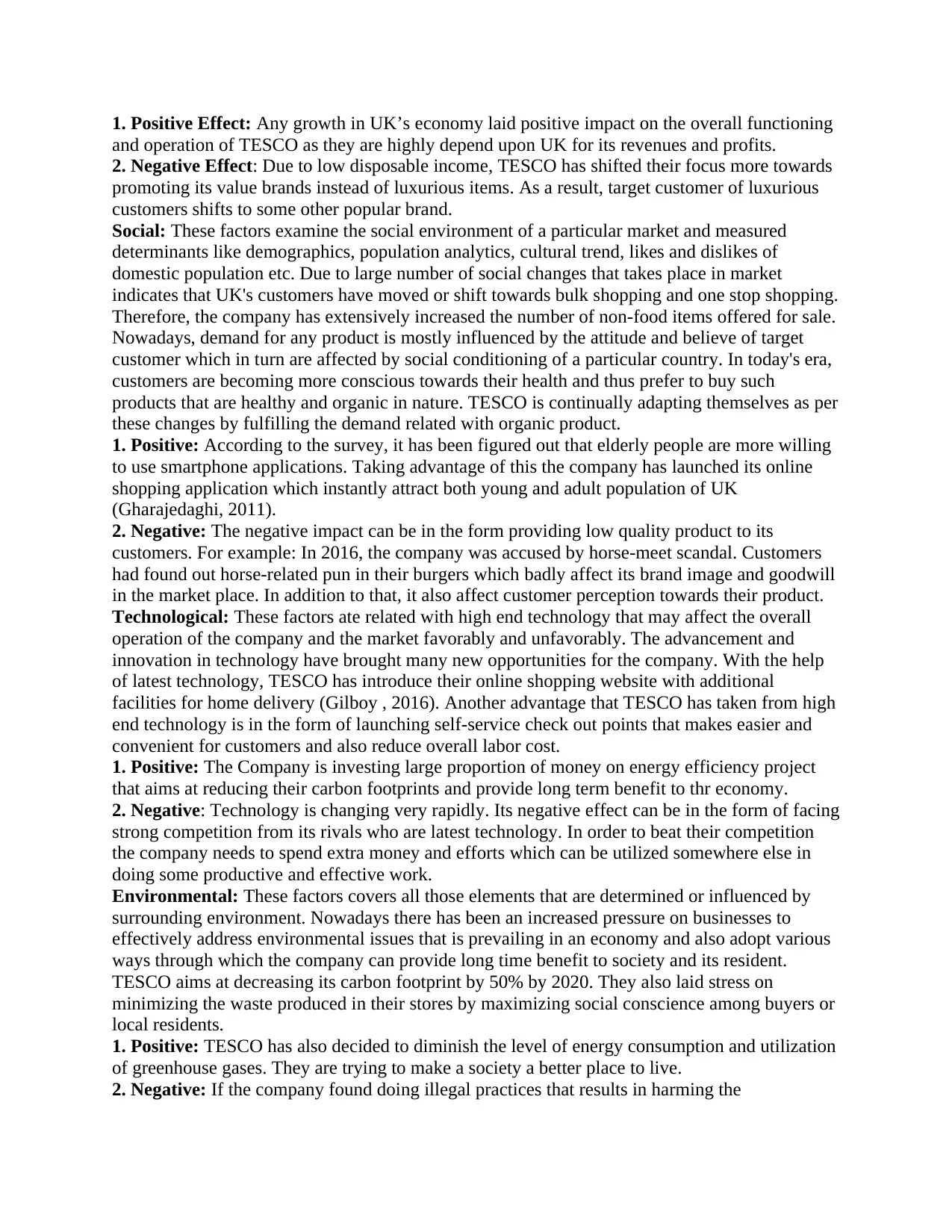
1. Positive Effect: Any growth in UK’s economy laid positive impact on the overall functioning
and operation of TESCO as they are highly depend upon UK for its revenues and profits.
2. Negative Effect: Due to low disposable income, TESCO has shifted their focus more towards
promoting its value brands instead of luxurious items. As a result, target customer of luxurious
customers shifts to some other popular brand.
Social: These factors examine the social environment of a particular market and measured
determinants like demographics, population analytics, cultural trend, likes and dislikes of
domestic population etc. Due to large number of social changes that takes place in market
indicates that UK's customers have moved or shift towards bulk shopping and one stop shopping.
Therefore, the company has extensively increased the number of non-food items offered for sale.
Nowadays, demand for any product is mostly influenced by the attitude and believe of target
customer which in turn are affected by social conditioning of a particular country. In today's era,
customers are becoming more conscious towards their health and thus prefer to buy such
products that are healthy and organic in nature. TESCO is continually adapting themselves as per
these changes by fulfilling the demand related with organic product.
1. Positive: According to the survey, it has been figured out that elderly people are more willing
to use smartphone applications. Taking advantage of this the company has launched its online
shopping application which instantly attract both young and adult population of UK
(Gharajedaghi, 2011).
2. Negative: The negative impact can be in the form providing low quality product to its
customers. For example: In 2016, the company was accused by horse-meet scandal. Customers
had found out horse-related pun in their burgers which badly affect its brand image and goodwill
in the market place. In addition to that, it also affect customer perception towards their product.
Technological: These factors ate related with high end technology that may affect the overall
operation of the company and the market favorably and unfavorably. The advancement and
innovation in technology have brought many new opportunities for the company. With the help
of latest technology, TESCO has introduce their online shopping website with additional
facilities for home delivery (Gilboy , 2016). Another advantage that TESCO has taken from high
end technology is in the form of launching self-service check out points that makes easier and
convenient for customers and also reduce overall labor cost.
1. Positive: The Company is investing large proportion of money on energy efficiency project
that aims at reducing their carbon footprints and provide long term benefit to thr economy.
2. Negative: Technology is changing very rapidly. Its negative effect can be in the form of facing
strong competition from its rivals who are latest technology. In order to beat their competition
the company needs to spend extra money and efforts which can be utilized somewhere else in
doing some productive and effective work.
Environmental: These factors covers all those elements that are determined or influenced by
surrounding environment. Nowadays there has been an increased pressure on businesses to
effectively address environmental issues that is prevailing in an economy and also adopt various
ways through which the company can provide long time benefit to society and its resident.
TESCO aims at decreasing its carbon footprint by 50% by 2020. They also laid stress on
minimizing the waste produced in their stores by maximizing social conscience among buyers or
local residents.
1. Positive: TESCO has also decided to diminish the level of energy consumption and utilization
of greenhouse gases. They are trying to make a society a better place to live.
2. Negative: If the company found doing illegal practices that results in harming the
and operation of TESCO as they are highly depend upon UK for its revenues and profits.
2. Negative Effect: Due to low disposable income, TESCO has shifted their focus more towards
promoting its value brands instead of luxurious items. As a result, target customer of luxurious
customers shifts to some other popular brand.
Social: These factors examine the social environment of a particular market and measured
determinants like demographics, population analytics, cultural trend, likes and dislikes of
domestic population etc. Due to large number of social changes that takes place in market
indicates that UK's customers have moved or shift towards bulk shopping and one stop shopping.
Therefore, the company has extensively increased the number of non-food items offered for sale.
Nowadays, demand for any product is mostly influenced by the attitude and believe of target
customer which in turn are affected by social conditioning of a particular country. In today's era,
customers are becoming more conscious towards their health and thus prefer to buy such
products that are healthy and organic in nature. TESCO is continually adapting themselves as per
these changes by fulfilling the demand related with organic product.
1. Positive: According to the survey, it has been figured out that elderly people are more willing
to use smartphone applications. Taking advantage of this the company has launched its online
shopping application which instantly attract both young and adult population of UK
(Gharajedaghi, 2011).
2. Negative: The negative impact can be in the form providing low quality product to its
customers. For example: In 2016, the company was accused by horse-meet scandal. Customers
had found out horse-related pun in their burgers which badly affect its brand image and goodwill
in the market place. In addition to that, it also affect customer perception towards their product.
Technological: These factors ate related with high end technology that may affect the overall
operation of the company and the market favorably and unfavorably. The advancement and
innovation in technology have brought many new opportunities for the company. With the help
of latest technology, TESCO has introduce their online shopping website with additional
facilities for home delivery (Gilboy , 2016). Another advantage that TESCO has taken from high
end technology is in the form of launching self-service check out points that makes easier and
convenient for customers and also reduce overall labor cost.
1. Positive: The Company is investing large proportion of money on energy efficiency project
that aims at reducing their carbon footprints and provide long term benefit to thr economy.
2. Negative: Technology is changing very rapidly. Its negative effect can be in the form of facing
strong competition from its rivals who are latest technology. In order to beat their competition
the company needs to spend extra money and efforts which can be utilized somewhere else in
doing some productive and effective work.
Environmental: These factors covers all those elements that are determined or influenced by
surrounding environment. Nowadays there has been an increased pressure on businesses to
effectively address environmental issues that is prevailing in an economy and also adopt various
ways through which the company can provide long time benefit to society and its resident.
TESCO aims at decreasing its carbon footprint by 50% by 2020. They also laid stress on
minimizing the waste produced in their stores by maximizing social conscience among buyers or
local residents.
1. Positive: TESCO has also decided to diminish the level of energy consumption and utilization
of greenhouse gases. They are trying to make a society a better place to live.
2. Negative: If the company found doing illegal practices that results in harming the
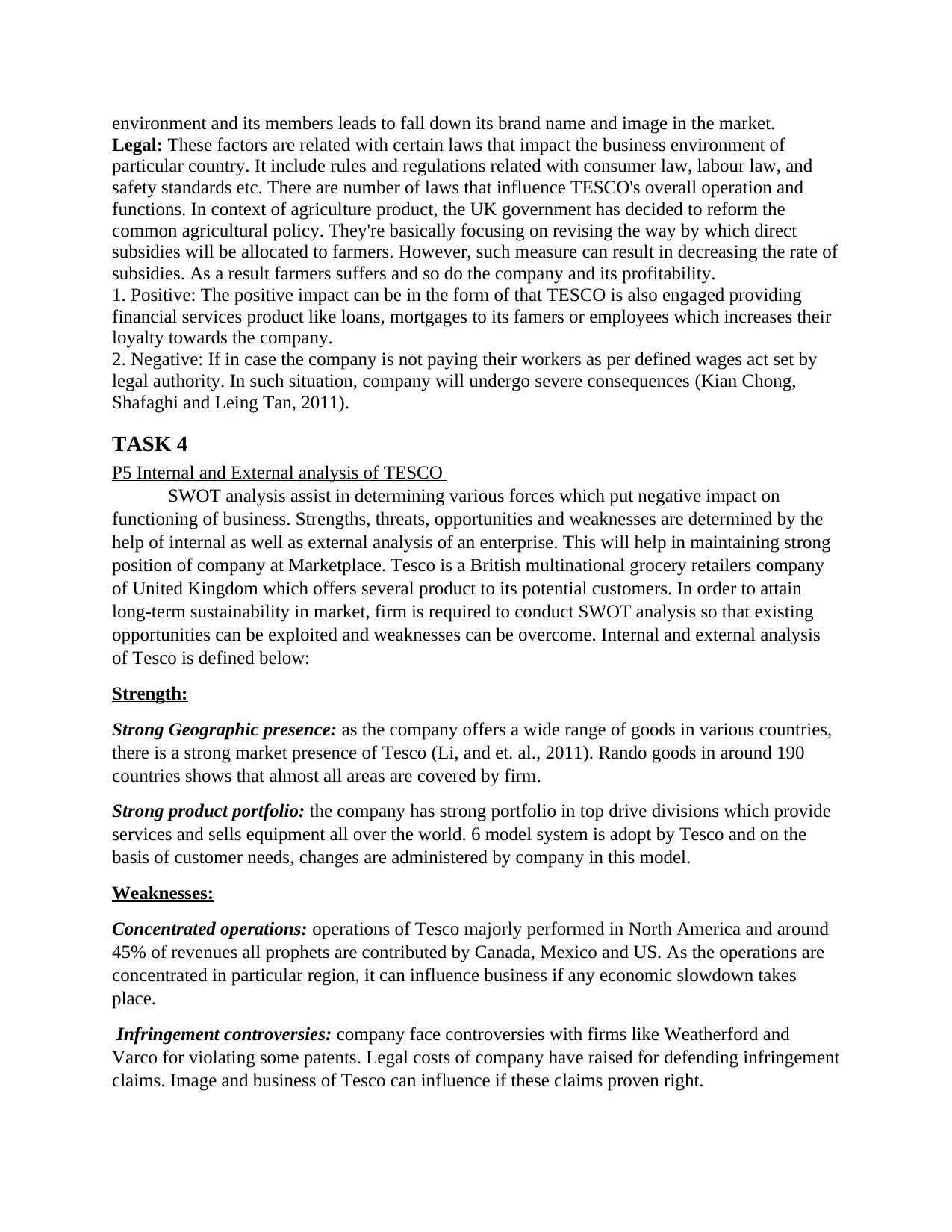
environment and its members leads to fall down its brand name and image in the market.
Legal: These factors are related with certain laws that impact the business environment of
particular country. It include rules and regulations related with consumer law, labour law, and
safety standards etc. There are number of laws that influence TESCO's overall operation and
functions. In context of agriculture product, the UK government has decided to reform the
common agricultural policy. They're basically focusing on revising the way by which direct
subsidies will be allocated to farmers. However, such measure can result in decreasing the rate of
subsidies. As a result farmers suffers and so do the company and its profitability.
1. Positive: The positive impact can be in the form of that TESCO is also engaged providing
financial services product like loans, mortgages to its famers or employees which increases their
loyalty towards the company.
2. Negative: If in case the company is not paying their workers as per defined wages act set by
legal authority. In such situation, company will undergo severe consequences (Kian Chong,
Shafaghi and Leing Tan, 2011).
TASK 4
P5 Internal and External analysis of TESCO
SWOT analysis assist in determining various forces which put negative impact on
functioning of business. Strengths, threats, opportunities and weaknesses are determined by the
help of internal as well as external analysis of an enterprise. This will help in maintaining strong
position of company at Marketplace. Tesco is a British multinational grocery retailers company
of United Kingdom which offers several product to its potential customers. In order to attain
long-term sustainability in market, firm is required to conduct SWOT analysis so that existing
opportunities can be exploited and weaknesses can be overcome. Internal and external analysis
of Tesco is defined below:
Strength:
Strong Geographic presence: as the company offers a wide range of goods in various countries,
there is a strong market presence of Tesco (Li, and et. al., 2011). Rando goods in around 190
countries shows that almost all areas are covered by firm.
Strong product portfolio: the company has strong portfolio in top drive divisions which provide
services and sells equipment all over the world. 6 model system is adopt by Tesco and on the
basis of customer needs, changes are administered by company in this model.
Weaknesses:
Concentrated operations: operations of Tesco majorly performed in North America and around
45% of revenues all prophets are contributed by Canada, Mexico and US. As the operations are
concentrated in particular region, it can influence business if any economic slowdown takes
place.
Infringement controversies: company face controversies with firms like Weatherford and
Varco for violating some patents. Legal costs of company have raised for defending infringement
claims. Image and business of Tesco can influence if these claims proven right.
Legal: These factors are related with certain laws that impact the business environment of
particular country. It include rules and regulations related with consumer law, labour law, and
safety standards etc. There are number of laws that influence TESCO's overall operation and
functions. In context of agriculture product, the UK government has decided to reform the
common agricultural policy. They're basically focusing on revising the way by which direct
subsidies will be allocated to farmers. However, such measure can result in decreasing the rate of
subsidies. As a result farmers suffers and so do the company and its profitability.
1. Positive: The positive impact can be in the form of that TESCO is also engaged providing
financial services product like loans, mortgages to its famers or employees which increases their
loyalty towards the company.
2. Negative: If in case the company is not paying their workers as per defined wages act set by
legal authority. In such situation, company will undergo severe consequences (Kian Chong,
Shafaghi and Leing Tan, 2011).
TASK 4
P5 Internal and External analysis of TESCO
SWOT analysis assist in determining various forces which put negative impact on
functioning of business. Strengths, threats, opportunities and weaknesses are determined by the
help of internal as well as external analysis of an enterprise. This will help in maintaining strong
position of company at Marketplace. Tesco is a British multinational grocery retailers company
of United Kingdom which offers several product to its potential customers. In order to attain
long-term sustainability in market, firm is required to conduct SWOT analysis so that existing
opportunities can be exploited and weaknesses can be overcome. Internal and external analysis
of Tesco is defined below:
Strength:
Strong Geographic presence: as the company offers a wide range of goods in various countries,
there is a strong market presence of Tesco (Li, and et. al., 2011). Rando goods in around 190
countries shows that almost all areas are covered by firm.
Strong product portfolio: the company has strong portfolio in top drive divisions which provide
services and sells equipment all over the world. 6 model system is adopt by Tesco and on the
basis of customer needs, changes are administered by company in this model.
Weaknesses:
Concentrated operations: operations of Tesco majorly performed in North America and around
45% of revenues all prophets are contributed by Canada, Mexico and US. As the operations are
concentrated in particular region, it can influence business if any economic slowdown takes
place.
Infringement controversies: company face controversies with firms like Weatherford and
Varco for violating some patents. Legal costs of company have raised for defending infringement
claims. Image and business of Tesco can influence if these claims proven right.
⊘ This is a preview!⊘
Do you want full access?
Subscribe today to unlock all pages.

Trusted by 1+ million students worldwide
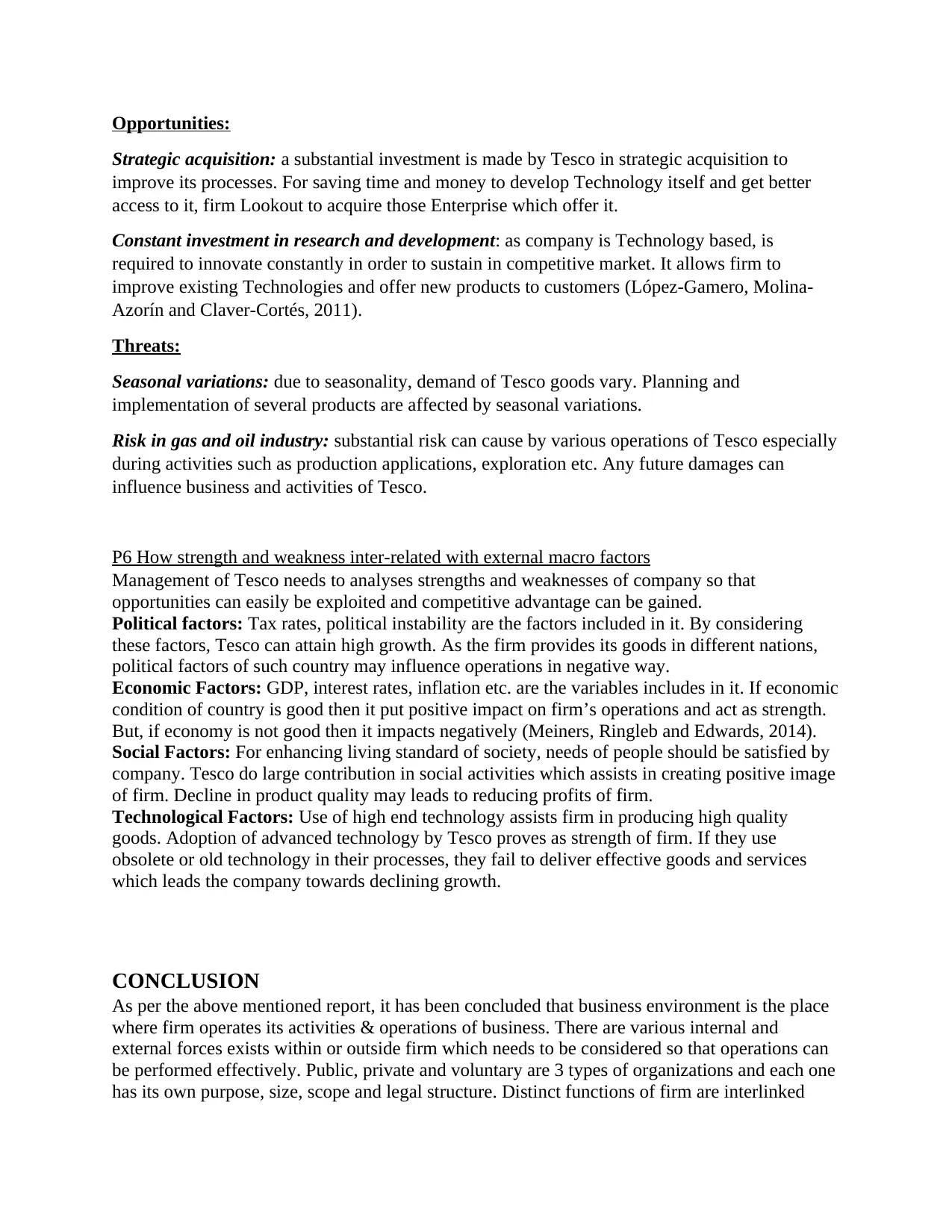
Opportunities:
Strategic acquisition: a substantial investment is made by Tesco in strategic acquisition to
improve its processes. For saving time and money to develop Technology itself and get better
access to it, firm Lookout to acquire those Enterprise which offer it.
Constant investment in research and development: as company is Technology based, is
required to innovate constantly in order to sustain in competitive market. It allows firm to
improve existing Technologies and offer new products to customers (López-Gamero, Molina-
Azorín and Claver-Cortés, 2011).
Threats:
Seasonal variations: due to seasonality, demand of Tesco goods vary. Planning and
implementation of several products are affected by seasonal variations.
Risk in gas and oil industry: substantial risk can cause by various operations of Tesco especially
during activities such as production applications, exploration etc. Any future damages can
influence business and activities of Tesco.
P6 How strength and weakness inter-related with external macro factors
Management of Tesco needs to analyses strengths and weaknesses of company so that
opportunities can easily be exploited and competitive advantage can be gained.
Political factors: Tax rates, political instability are the factors included in it. By considering
these factors, Tesco can attain high growth. As the firm provides its goods in different nations,
political factors of such country may influence operations in negative way.
Economic Factors: GDP, interest rates, inflation etc. are the variables includes in it. If economic
condition of country is good then it put positive impact on firm’s operations and act as strength.
But, if economy is not good then it impacts negatively (Meiners, Ringleb and Edwards, 2014).
Social Factors: For enhancing living standard of society, needs of people should be satisfied by
company. Tesco do large contribution in social activities which assists in creating positive image
of firm. Decline in product quality may leads to reducing profits of firm.
Technological Factors: Use of high end technology assists firm in producing high quality
goods. Adoption of advanced technology by Tesco proves as strength of firm. If they use
obsolete or old technology in their processes, they fail to deliver effective goods and services
which leads the company towards declining growth.
CONCLUSION
As per the above mentioned report, it has been concluded that business environment is the place
where firm operates its activities & operations of business. There are various internal and
external forces exists within or outside firm which needs to be considered so that operations can
be performed effectively. Public, private and voluntary are 3 types of organizations and each one
has its own purpose, size, scope and legal structure. Distinct functions of firm are interlinked
Strategic acquisition: a substantial investment is made by Tesco in strategic acquisition to
improve its processes. For saving time and money to develop Technology itself and get better
access to it, firm Lookout to acquire those Enterprise which offer it.
Constant investment in research and development: as company is Technology based, is
required to innovate constantly in order to sustain in competitive market. It allows firm to
improve existing Technologies and offer new products to customers (López-Gamero, Molina-
Azorín and Claver-Cortés, 2011).
Threats:
Seasonal variations: due to seasonality, demand of Tesco goods vary. Planning and
implementation of several products are affected by seasonal variations.
Risk in gas and oil industry: substantial risk can cause by various operations of Tesco especially
during activities such as production applications, exploration etc. Any future damages can
influence business and activities of Tesco.
P6 How strength and weakness inter-related with external macro factors
Management of Tesco needs to analyses strengths and weaknesses of company so that
opportunities can easily be exploited and competitive advantage can be gained.
Political factors: Tax rates, political instability are the factors included in it. By considering
these factors, Tesco can attain high growth. As the firm provides its goods in different nations,
political factors of such country may influence operations in negative way.
Economic Factors: GDP, interest rates, inflation etc. are the variables includes in it. If economic
condition of country is good then it put positive impact on firm’s operations and act as strength.
But, if economy is not good then it impacts negatively (Meiners, Ringleb and Edwards, 2014).
Social Factors: For enhancing living standard of society, needs of people should be satisfied by
company. Tesco do large contribution in social activities which assists in creating positive image
of firm. Decline in product quality may leads to reducing profits of firm.
Technological Factors: Use of high end technology assists firm in producing high quality
goods. Adoption of advanced technology by Tesco proves as strength of firm. If they use
obsolete or old technology in their processes, they fail to deliver effective goods and services
which leads the company towards declining growth.
CONCLUSION
As per the above mentioned report, it has been concluded that business environment is the place
where firm operates its activities & operations of business. There are various internal and
external forces exists within or outside firm which needs to be considered so that operations can
be performed effectively. Public, private and voluntary are 3 types of organizations and each one
has its own purpose, size, scope and legal structure. Distinct functions of firm are interlinked
Paraphrase This Document
Need a fresh take? Get an instant paraphrase of this document with our AI Paraphraser
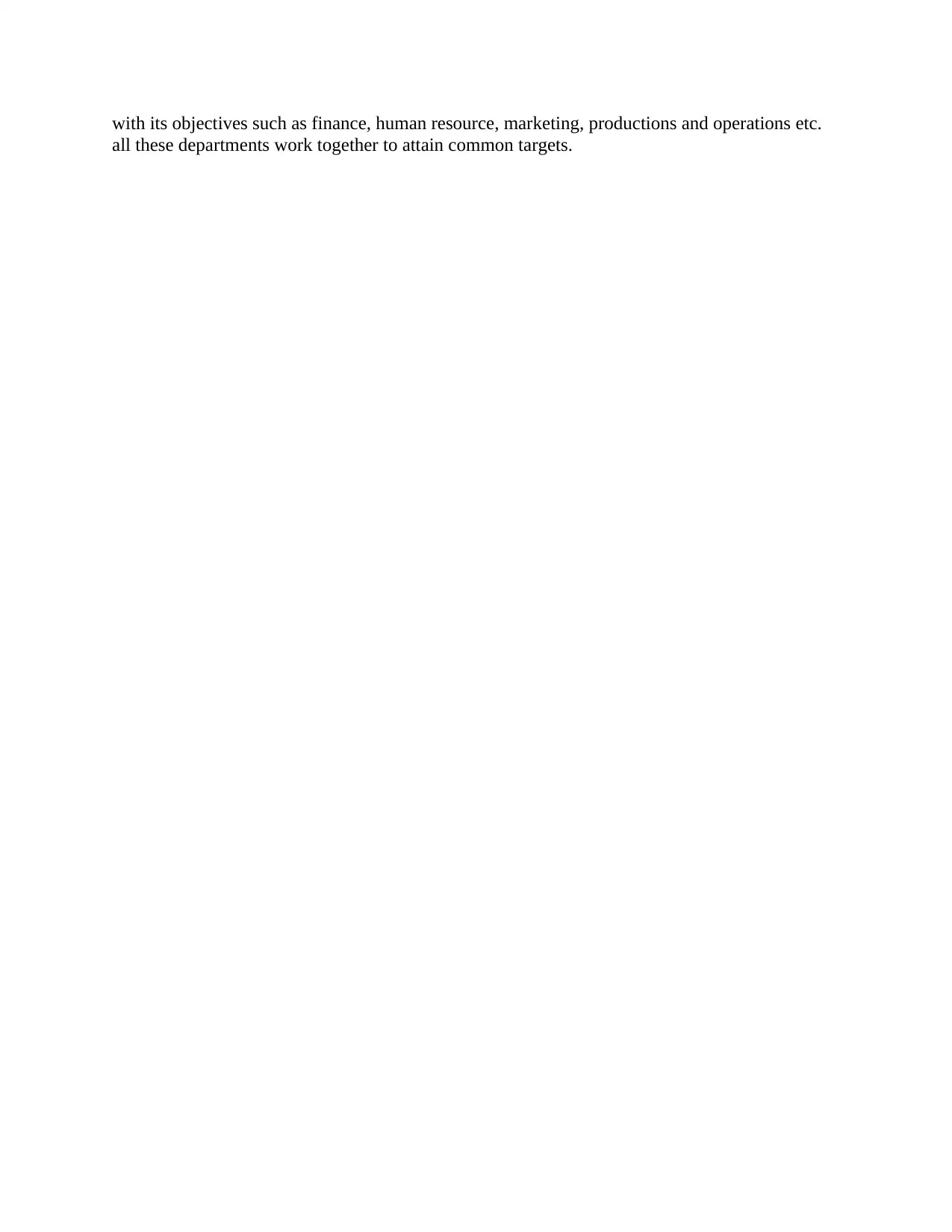
with its objectives such as finance, human resource, marketing, productions and operations etc.
all these departments work together to attain common targets.
all these departments work together to attain common targets.
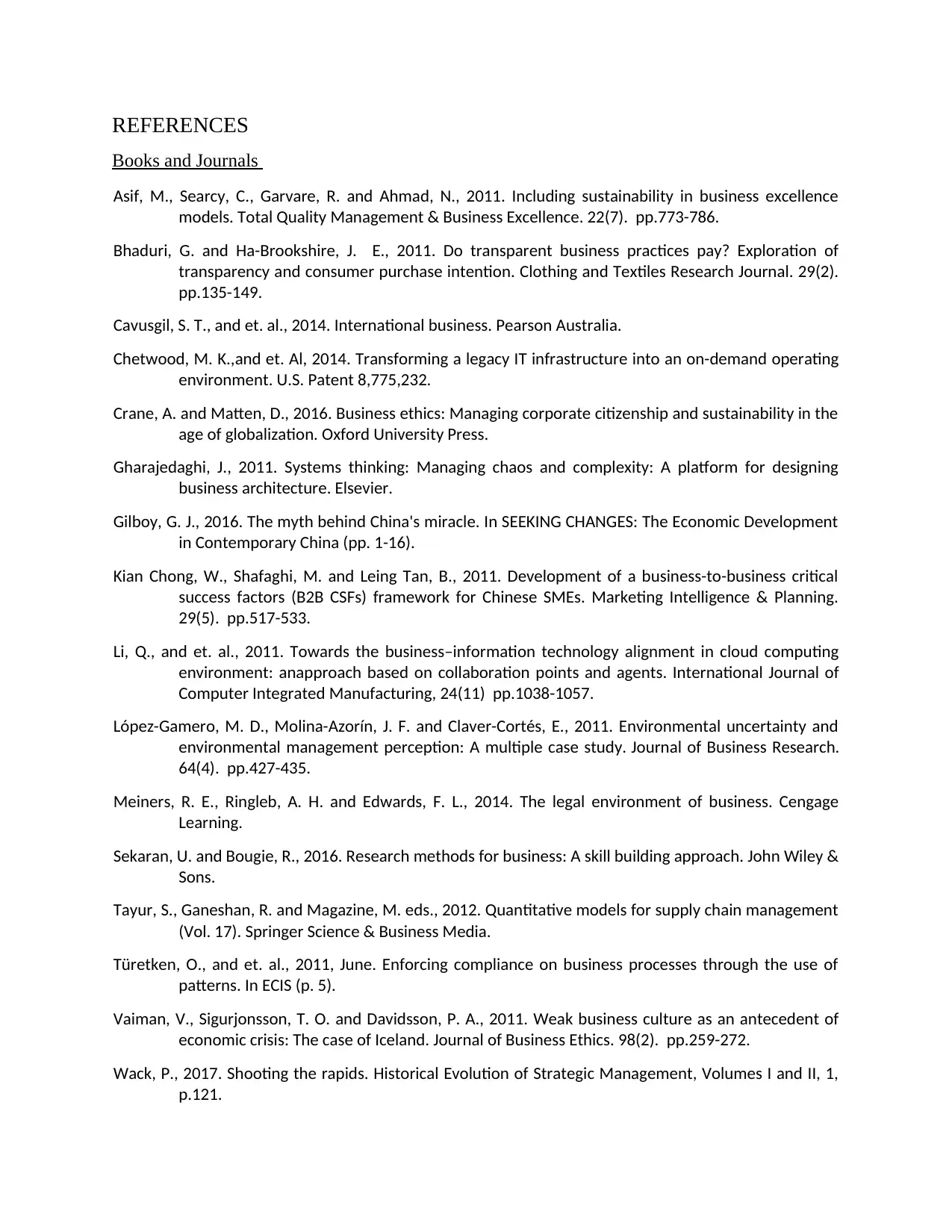
REFERENCES
Books and Journals
Asif, M., Searcy, C., Garvare, R. and Ahmad, N., 2011. Including sustainability in business excellence
models. Total Quality Management & Business Excellence. 22(7). pp.773-786.
Bhaduri, G. and Ha-Brookshire, J. E., 2011. Do transparent business practices pay? Exploration of
transparency and consumer purchase intention. Clothing and Textiles Research Journal. 29(2).
pp.135-149.
Cavusgil, S. T., and et. al., 2014. International business. Pearson Australia.
Chetwood, M. K.,and et. Al, 2014. Transforming a legacy IT infrastructure into an on-demand operating
environment. U.S. Patent 8,775,232.
Crane, A. and Matten, D., 2016. Business ethics: Managing corporate citizenship and sustainability in the
age of globalization. Oxford University Press.
Gharajedaghi, J., 2011. Systems thinking: Managing chaos and complexity: A platform for designing
business architecture. Elsevier.
Gilboy, G. J., 2016. The myth behind China's miracle. In SEEKING CHANGES: The Economic Development
in Contemporary China (pp. 1-16).
Kian Chong, W., Shafaghi, M. and Leing Tan, B., 2011. Development of a business-to-business critical
success factors (B2B CSFs) framework for Chinese SMEs. Marketing Intelligence & Planning.
29(5). pp.517-533.
Li, Q., and et. al., 2011. Towards the business–information technology alignment in cloud computing
environment: anapproach based on collaboration points and agents. International Journal of
Computer Integrated Manufacturing, 24(11) pp.1038-1057.
López-Gamero, M. D., Molina-Azorín, J. F. and Claver-Cortés, E., 2011. Environmental uncertainty and
environmental management perception: A multiple case study. Journal of Business Research.
64(4). pp.427-435.
Meiners, R. E., Ringleb, A. H. and Edwards, F. L., 2014. The legal environment of business. Cengage
Learning.
Sekaran, U. and Bougie, R., 2016. Research methods for business: A skill building approach. John Wiley &
Sons.
Tayur, S., Ganeshan, R. and Magazine, M. eds., 2012. Quantitative models for supply chain management
(Vol. 17). Springer Science & Business Media.
Türetken, O., and et. al., 2011, June. Enforcing compliance on business processes through the use of
patterns. In ECIS (p. 5).
Vaiman, V., Sigurjonsson, T. O. and Davidsson, P. A., 2011. Weak business culture as an antecedent of
economic crisis: The case of Iceland. Journal of Business Ethics. 98(2). pp.259-272.
Wack, P., 2017. Shooting the rapids. Historical Evolution of Strategic Management, Volumes I and II, 1,
p.121.
Books and Journals
Asif, M., Searcy, C., Garvare, R. and Ahmad, N., 2011. Including sustainability in business excellence
models. Total Quality Management & Business Excellence. 22(7). pp.773-786.
Bhaduri, G. and Ha-Brookshire, J. E., 2011. Do transparent business practices pay? Exploration of
transparency and consumer purchase intention. Clothing and Textiles Research Journal. 29(2).
pp.135-149.
Cavusgil, S. T., and et. al., 2014. International business. Pearson Australia.
Chetwood, M. K.,and et. Al, 2014. Transforming a legacy IT infrastructure into an on-demand operating
environment. U.S. Patent 8,775,232.
Crane, A. and Matten, D., 2016. Business ethics: Managing corporate citizenship and sustainability in the
age of globalization. Oxford University Press.
Gharajedaghi, J., 2011. Systems thinking: Managing chaos and complexity: A platform for designing
business architecture. Elsevier.
Gilboy, G. J., 2016. The myth behind China's miracle. In SEEKING CHANGES: The Economic Development
in Contemporary China (pp. 1-16).
Kian Chong, W., Shafaghi, M. and Leing Tan, B., 2011. Development of a business-to-business critical
success factors (B2B CSFs) framework for Chinese SMEs. Marketing Intelligence & Planning.
29(5). pp.517-533.
Li, Q., and et. al., 2011. Towards the business–information technology alignment in cloud computing
environment: anapproach based on collaboration points and agents. International Journal of
Computer Integrated Manufacturing, 24(11) pp.1038-1057.
López-Gamero, M. D., Molina-Azorín, J. F. and Claver-Cortés, E., 2011. Environmental uncertainty and
environmental management perception: A multiple case study. Journal of Business Research.
64(4). pp.427-435.
Meiners, R. E., Ringleb, A. H. and Edwards, F. L., 2014. The legal environment of business. Cengage
Learning.
Sekaran, U. and Bougie, R., 2016. Research methods for business: A skill building approach. John Wiley &
Sons.
Tayur, S., Ganeshan, R. and Magazine, M. eds., 2012. Quantitative models for supply chain management
(Vol. 17). Springer Science & Business Media.
Türetken, O., and et. al., 2011, June. Enforcing compliance on business processes through the use of
patterns. In ECIS (p. 5).
Vaiman, V., Sigurjonsson, T. O. and Davidsson, P. A., 2011. Weak business culture as an antecedent of
economic crisis: The case of Iceland. Journal of Business Ethics. 98(2). pp.259-272.
Wack, P., 2017. Shooting the rapids. Historical Evolution of Strategic Management, Volumes I and II, 1,
p.121.
⊘ This is a preview!⊘
Do you want full access?
Subscribe today to unlock all pages.

Trusted by 1+ million students worldwide
1 out of 13
Related Documents
Your All-in-One AI-Powered Toolkit for Academic Success.
+13062052269
info@desklib.com
Available 24*7 on WhatsApp / Email
![[object Object]](/_next/static/media/star-bottom.7253800d.svg)
Unlock your academic potential
Copyright © 2020–2025 A2Z Services. All Rights Reserved. Developed and managed by ZUCOL.





